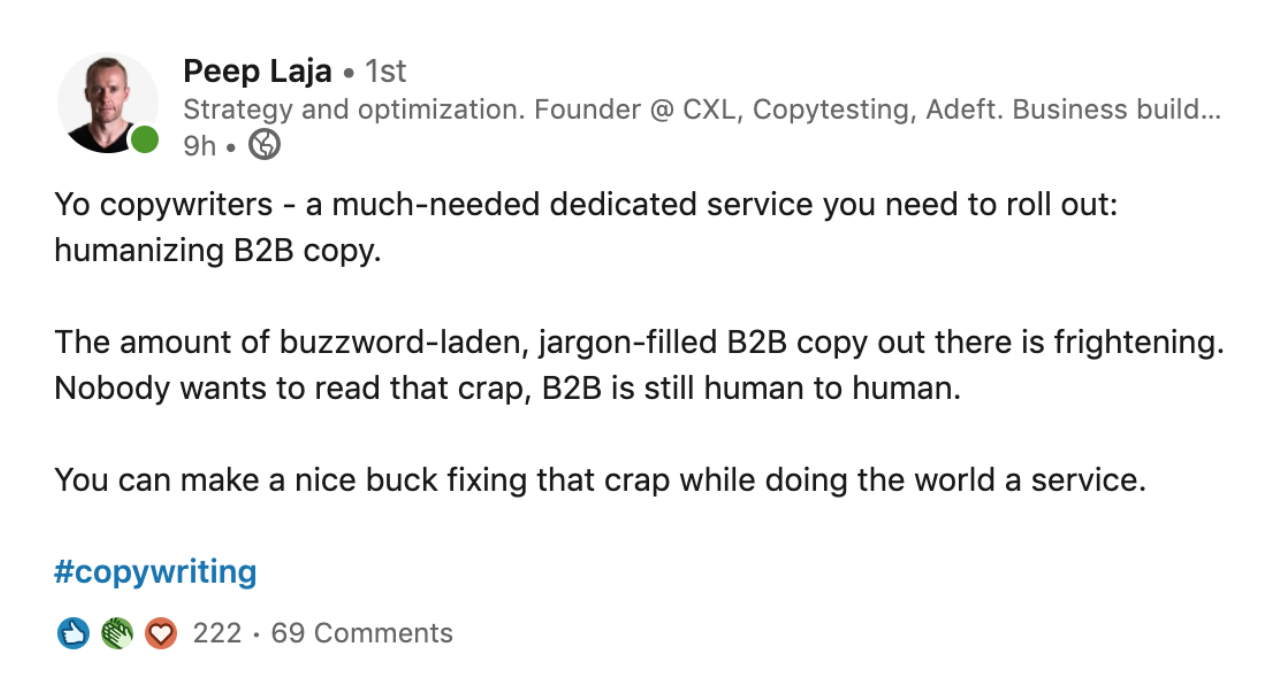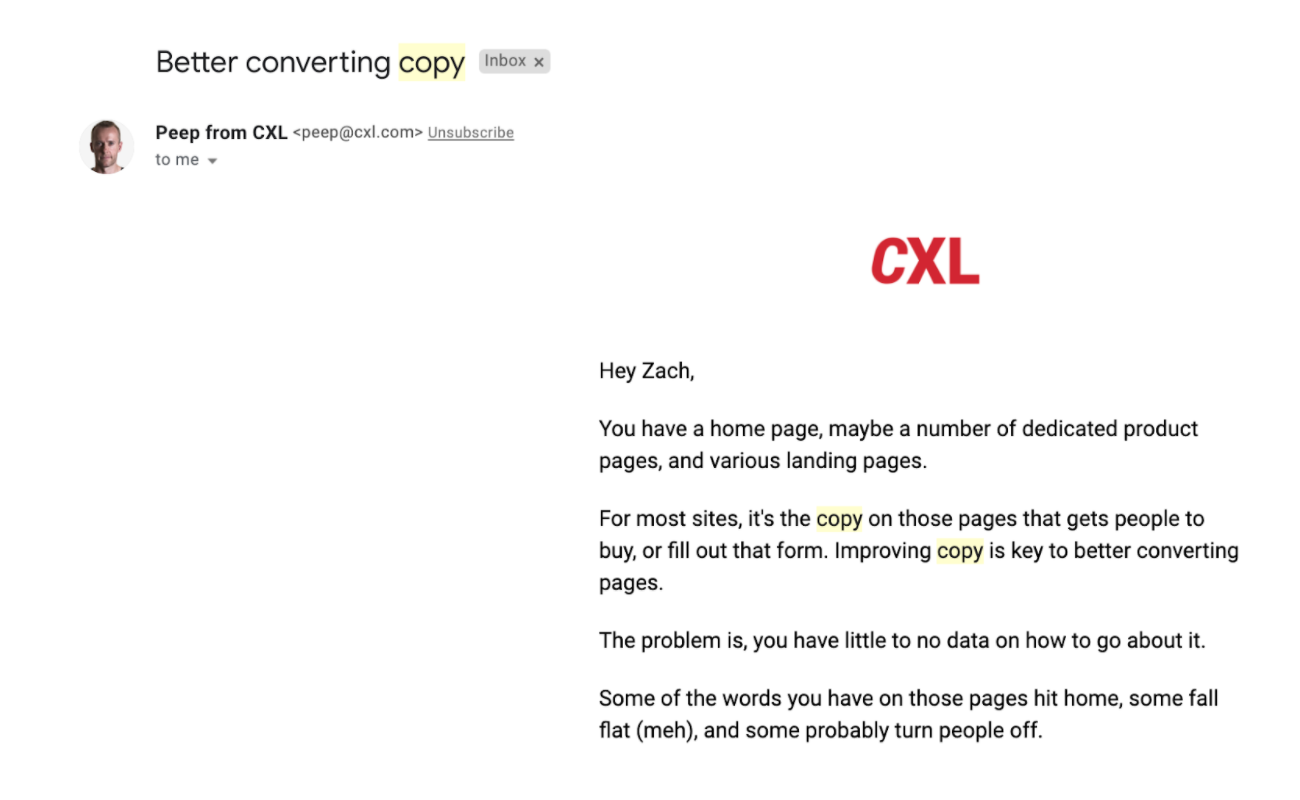A lot of marketers think cold email is a lackluster strategy.
The prevailing views cite single-digit open rates, nonexistent response rates, and a general feeling of uneasiness about the entire approach, like they might be spamming people.
In this view, cold email is more likely to harm your brand than help it.
But even 10 minutes of research will unearth case studies about how someone 10x’d their business using cold email.
So which opinion is true? Both are.
Most marketers fail at cold outreach because they’re just not good at it. The individuals who succeed with this strategy are a testament to its potential. But it takes good copywriting and research skills.
In short, you need to execute at an above average level. Luckily, this isn’t as mighty of a feat as it sounds.
In this post, I’ll explain 4 techniques to improve your cold email numbers and start bringing home some real ROI.
1. Be Exceptionally Relevant
Relevancy is the deciding factor in your cold email’s success and failure. If you’re not relevant, then you are indeed spam.
For instance, I used to work as a director of content at a UX design firm. I still regularly get emails from sales people at other agencies. They ask me about white labeling their services or hiring them outright to do development work.
Each and every one of these emails is spam, because I don’t work in UX design anymore. I work in YouTube royalty free music. These emails aren’t relevant to my life anymore.
The same phenomenon happens when you email someone out of the blue and start pitching your product. These people don’t know, and they don’t care about how they can help you by becoming a customer.
The path to relevancy
Know what matters
Being relevant to strangers may seem impossible at first. You’ve never met, so how can you know what’s important to them?
Take a deep breath, and repeat after me: do the research.
Send some customer surveys out. Hell, get a few of your existing customers on the phone and interview them about their biggest pain points. Monitor social media to see what your problems matter most in your industry.
Once you’ve done that, prioritize those pain points. If you’re not sure, take a guess. You can always test later.
Now, you’ve taken a few giant steps closer to being relevant. You’re not guessing, or just pitching, you’ve got an idea of what the people on the other end of your emails care about.
Show how your solution solves their problems
Alright, now it’s time to structure your email in such a way that explains how your solution actually helps people.
If you can do that successfully, you’re exponentially more likely to get people to respond to your email, which is the first step in actually converting someone into a customer.
To structure an email, I typically use the PSO method, or Problem, Solution, Outcome.
So start your email by talking specifically about the problem your audience is facing. Then transition to how your offer is a solution. Finally, round things off with the outcome your solution delivers.
By opening with a problem that your prospects are actually dealing with and proposing a solution, you’re proving that you understand them.
And if people think you understand what they’re going through, they’re more likely to hear what you have to say.
2. Keep It Casual
When you’re writing cold emails, go the extra mile to avoid sounding like a used-car dealer commercial. Stuffing jargon and overtly “business” language into marketing copy was over in 2005. It’s time to write like a human who’s writing to another human.
If you don’t believe me, maybe you’ll believe CXL Founder Peep Laja:

So how do you do it? Start writing the email as if you were writing to a coworker or a friend. Use contractions and short sentences. Don’t worry if everything isn’t a complete thought. Just make sure each sentence keeps the reader moving to the next one.
And most importantly, give people an obvious exit path.
In the last cold email campaign I sent, I included this copy with the unsubscribe link:
“Yes, this is an automated email, but I’m a real person trying to create long-lasting, valuable partnerships. If you don’t want to hear from me again, I get it. You can unsubscribe here.”
Giving people a choice makes cold email seem less like a sweaty used-car salesman and more like a colleague you met for coffee who wants to talk shop.
3. Use an open-loop subject line
Ever notice those super short subject lines in your inbox? They don’t come off as a marketing headline, but rather an email you would get from someone you know.
And that’s the point. By being more casual, these types of headlines actually grab your attention. But where you have context for an email sent from your boss, you don’t for these short subject lines.
Your curiosity is piqued, so you open the email to find out more. In the first line, the email explains more and persuades you to keep reading.
This technique is called the open-loop, because it plays on our inherent curiosity. In fact, that curiosity is the basis of all notifications.
We see a signal, and we want to “close the loop” by investigating and learning more. As a reward, our brain gives us a shot of dopamine. We feel satisfied that we’ve solved this oh so minor mystery.
Here’s an example from CXL for their new product Copytesting:

Notice how the headline just says “Better converting copy.” That doesn’t follow any of the traditional best practices for subject lines, besides maybe brevity.
Still, it’s powerful, because it speaks directly to something I’m interested in. So I open the email and low and behold it begins with a problem that I’m dealing with, i.e., lack of data on my copy.
To be clear, this isn’t a cold email, but it could very well be. It’s a textbook example of how to use an open-loop subject line to get someone to open the email and then direct them to keep reading more.
4. Prove You Can Do What You Say
Social proof makes the marketing world go round, and it’s no different with cold email. When you get to the “outcome” section of your email, you really need to bring the noise.
And by noise, I mean examples of how you’ve helped people who are similar to your reader achieve the results you’re promising. Ideally, these are web pages on your site, videos on YouTube, or other similarly public assets.
This is a surefire way to make your cold emails more effective, because it separates you from desperate spammers who almost never have any proof to back up their claims.
Look, cold email isn’t easy. And that’s why a lot — dare I say most — marketers fail at it. You have to know what your audience needs and write persuasive copy to convince them you can help them.
However, if you can check those two boxes, cold email is a low-investment, potential high-return strategy.
If you’ve run cold email campaigns before or you’re just setting out on your maiden email voyage, use the points above as a checklist. Does your copy meet all these requirements? Could it do so better?
Answering those questions will have a substantial impact on your success.
Zach is the content specialist at Soundstripe, a royalty free music company for content creators and businesses.
Fahrenheit is proudly featured as Top Real Estate Website Design Companie